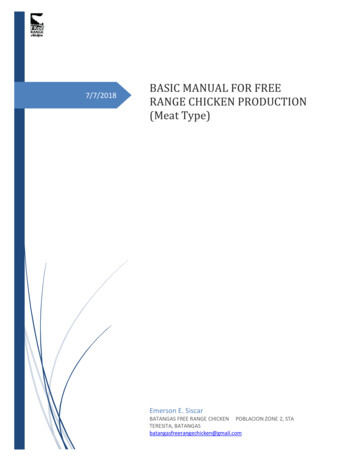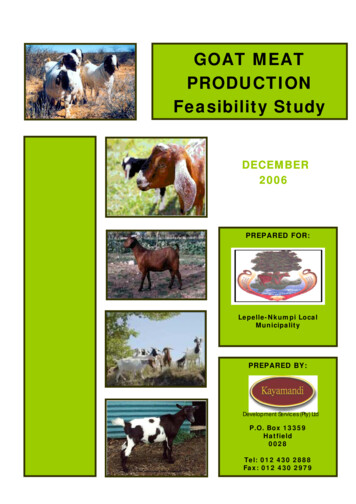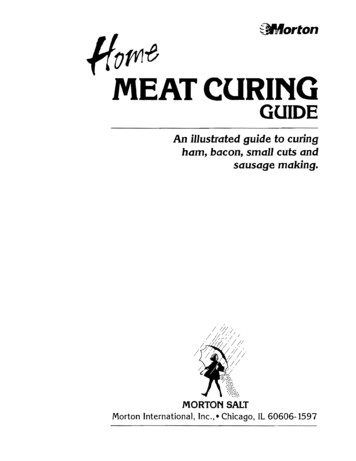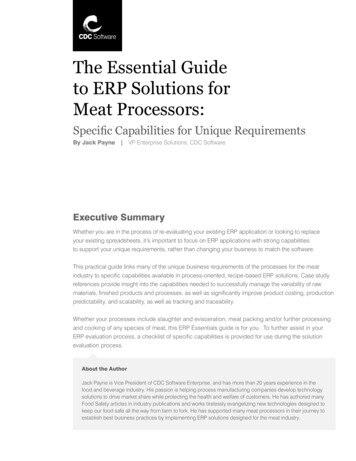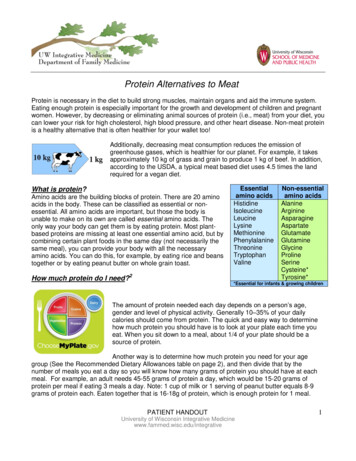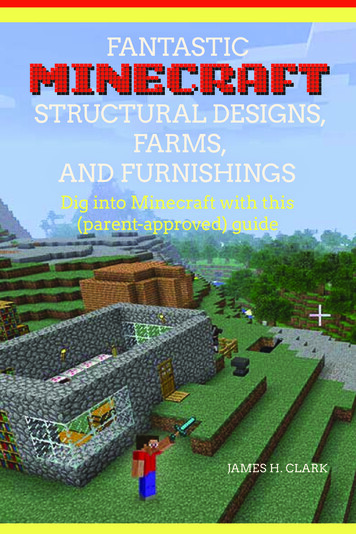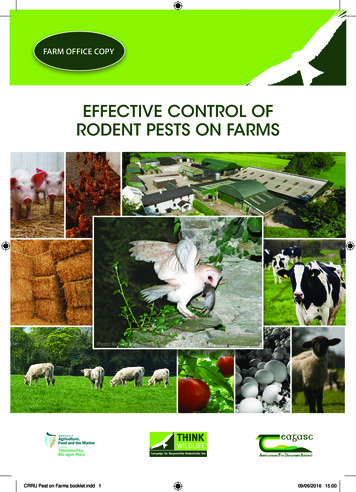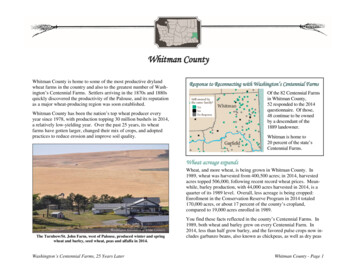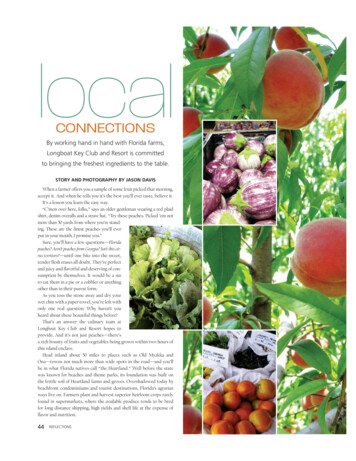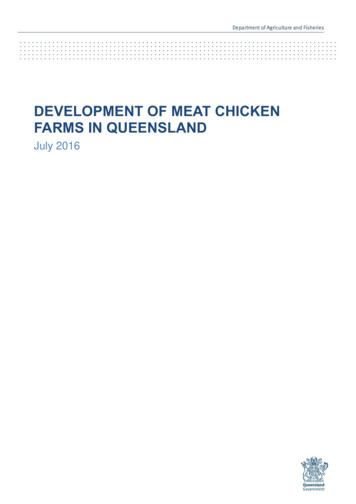
Transcription
DEVELOPMENT OF MEAT CHICKENFARMS IN QUEENSLANDJuly 2016
This publication has been compiled by Animal Industries, Department of Agriculture and Fisheries. State of Queensland, 2016.The Queensland Government supports and encourages the dissemination and exchange of its information. Thecopyright in this publication is licensed under a Creative Commons Attribution 3.0 Australia (CC BY) licence.Under this licence you are free, without having to seek our permission, to use this publication in accordance with thelicence terms.You must keep intact the copyright notice and attribute the State of Queensland as the source of the publication.Note: Some content in this publication may have different licence terms as indicated.For more information on this licence, visit .enThe information contained herein is subject to change without notice. The Queensland Government shall not be liable fortechnical or other errors or omissions contained herein. The reader/user accepts all risks and responsibility for losses,damages, costs and other consequences resulting directly or indirectly from using this information.
2.0Planning framework – relevant instruments52.12.22.32.4State Planning Regulatory ProvisionsState Planning PoliciesRegional PlanningStandard Planning Scheme Provisions55663.0The development assessment process83.13.23.33.3.13.3.23.3.33.3.4Is a development permit required?Pre-lodgement meetingThe stages of IDASApplication stageInformation and referral stageNotification stageDecision stage89991010114.0Environmental Authority125.0Planning and assessment of development applications125.15.25.3Location and site selectionNatural environmentFarm design1315156.0Operational and management considerations176.1Environmental Management dix 1 – Fixed buffer distances25Appendix 2 – Calculating separation distances26A 2.1 IntroductionA 2.2 Concepts in calculating separation distancesA 2.3 S-factor formula for calculating separation distancesA 2.3.1 Farm sizeA 2.3.2 Sensitive land use factor S1A 2.3.3 Surface roughness factor S2262627292929Development of Meat Chicken Farms in Queensland – July 20161
A 2.3.4 Terrain weighting factor S3A 2.4 Example calculation – S-factor formulaA 2.5 Multiple odour sources and cumulative impactsA 2.6 Plume dispersion modellingDevelopment of Meat Chicken Farms in Queensland – July 2016303133332
1.0 Overview1.1 The industryThe Queensland meat chicken industry makes a significant contribution to the Queensland economy. Thegross value of primary production for Queensland’s chicken meat sector was valued at 588 million in 2014151.Meat chicken farms are located close to processing plants to ensure the welfare of the chickens duringtransport and to minimise the cost of transporting the chickens.In the past, the locations of meat chicken farms in Queensland were typically on the urban fringe. Urbanencroachment has meant that meat chicken farms are now not always located in a rural setting—some arenow located within urban areas of South East Queensland (SEQ). Proximity to neighbours and urbancommunities raises the potential for issues such as odour, dust, pests, farm traffic, noise, and visual andlighting impacts. It is therefore crucial for new meat chicken farms to be appropriately located and operatedto ensure potential impacts on community health and amenity and the general environment are minimised.1.2 PurposeThe Development of Meat Chicken Farms in Queensland (the document) provides information for theplanning, design and development of meat chicken farms across Queensland. Whilst not a compliance,operational or management manual, it provides some advice on operational arrangements, where relevant,to managing the potential impact of meat chicken farms on the environment and broader community.The purpose of the document is to provide consistent information for the planning and development of meatchicken farms to: assist local government to include relevant provisions in Local Government Planning Schemes assist proponents with the development of a new meat chicken farm or the expansion of an existing farm provide information to assist local government officers in assessing development applications provide an overview of planning frameworks and the development assessment process provide information to assist local government to protect existing and approved poultry farms fromencroachment by development that would compromise the ability of the meat chicken farm to functionsafely and effectively.Use of the document by local governments and proponents will contribute to a more consistent decisionmaking process and increased certainty for the meat chicken industry whilst reducing community conflictresulting from the expansion of the industry.1.3 ScopeThe document applies to the development of new meat chicken farms and the expansion or renovation ofexisting meat chicken farms.The document is not designed to cover poultry farming activity other than meat chicken production. Eggproduction is excluded from this document because a significantly different production system is used. Freeto-range facilities are not considered as these require a specific site-by-site approach.The document recognises the structure of the industry, particularly the typical involvement of both growersand processors in meat chicken production. Usually the grower directly owns and operates the rearingfacility, while the processors provide and own the chickens, arrange transport, provide the feed, provideveterinary and management advice, and process and market the chickens. In most instances, the growerAustralian Bureau of Statistics. 7503.0 – Value of Agricultural Commodities Produced, Australia, 2014-15.23 March 2016.1Development of Meat Chicken Farms in Queensland – July 20163
operates under a contract with a processing company, and the ongoing performance of the farm is thereforedependent on the actions of both the grower and the processor.The document is not designed to provide site-specific details for all possible site variables and use of thedocument alone will not necessarily ensure compliance with all planning and environmental managementrequirements.This document describes the objectives and some acceptable outcomes that could be implemented whendeveloping a meat chicken farm.These requirements are provided for all parties with an interest in the development and operation of meatchicken farms, but in particular this document focuses on requirements to be taken into account when adevelopment application is being prepared or assessed.Proponents considering building a new facility, or expanding/renovating an existing farm, should use thisdocument to inform the planning and design of the facility and establishment of management practices tominimise environmental impacts.This document alone will not ensure good planning and environmental management outcomes, nor providean exhaustive list of acceptable solutions. Site-specific data, impact assessment and alternative solutions willalso be required in many instances.1.4 ReviewThe document is based on current information and knowledge.Further investigation, research and innovation in farm practice may in the future establish new and refinedpractices for the industry.The state government will from time to time revise the document as new peer reviewed information relatingto the design, operation, management and environmental impact of meat chicken farms becomes available.Development of Meat Chicken Farms in Queensland – July 20164
2.0 Planning framework – relevant instrumentsThe Sustainable Planning Act 2009 (SP Act) provides a framework to achieve ecological sustainability bymanaging the process by which development takes place. This includes ensuring the process isaccountable, effective and efficient and delivers sustainable outcomes; and managing the effects ofdevelopment on the environment, including managing the use of the premises; and integration of planning atlocal, regional and State levels.Local government planning schemes describe a council’s plan for the future direction of a particular localgovernment area. Planning schemes provide a detailed direction for the area focusing on communityplanning and aspirations, whilst ensuring the needs of the state and the regional community areincorporated.Planning schemes must appropriately reflect the standard planning scheme provisions; identify the strategicoutcomes for the planning scheme area; include measures that facilitate achieving the strategic outcomes;coordinate and integrate community, state and regional needs and wants; include a priority infrastructureplan; and include a structure plan for any master planned areas within the local government area.Local planning integrates and balances economic, social and environmental needs and aspirations of thelocal community to provide an orderly approach to land use and change with a focus on land use,development, infrastructure and valuable features of the area.State planning instruments are statutory instruments that articulate the government’s position on planningand development related issues and provide for the protection and management of those issues within theplanning and development system.There are four types of State planning instruments under the SP Act:1. State Planning Regulatory Provisions2. State Planning Policies3. Regional Plans4. Standard Planning Scheme Provisions.2.1State Planning Regulatory ProvisionsState planning regulatory provisions are state planning instruments that regulate development and can applyto all or part of the state.They can be used in the following circumstances:1. To provide regulatory support for regional planning and master planning2. To provide for charges for infrastructure3. To protect planning scheme areas from adverse environmental, cultural, economic or socialconditions.State planning regulatory provisions may specify categories of development, including prohibiteddevelopment; specify levels of assessment, such as code assessment or impact assessment; include a codeor other criteria to be used in development assessment; otherwise regulate development; provide for mattersin which the state planning regulatory provision can apply.2.2 State Planning PoliciesThe Queensland Government established the state planning policy (SPP) in December 2013 to simplify andclarify matters of state interest in land use planning and development.State interests can apply to the whole or part of the state and provide overall policy direction for regionalplans and for local governments' planning schemes. They may also provide detailed codes and standardsused in technical aspects of development assessment. SPPs must be considered in assessing and decidingan application. They also have effect in preparing and amending planning schemes.Development of Meat Chicken Farms in Queensland – July 20165
The SPP which replaced multiple state planning policies, is a key component of Queensland’s land useplanning system that enables development, protects our natural environment and allows communities togrow and prosper.The SPP provides clarity to local governments when making and amending local planning instruments andassessing development applications and assists developers in preparing development applications. SPPsmust be considered in assessing and deciding an application. They also have effect in preparing andamending planning schemes.The SPP is supported by state interest guidelines which are provided to assist the implementation of thepolicy.SPPs should be considered when identifying land for a meat chicken farm. The SPP addresses thecompatibility of land uses and provides advice on separation distances required between meat chicken farmsand other forms of development.2.3Regional PlanningThe Regional Plans seek to provide strategic direction to achieve regional outcomes that align with thestate’s interest in planning and development.Land use planning is primarily the responsibility of local government. However, the State has an interest inensuring that broader regional outcomes are achieved through the application of state policy in localplanning.The regional plans identify regional outcomes to help achieve state interests. Regional policies are used tofacilitate these outcomes by addressing existing or emerging regional issues, such as competition betweenland uses.Regional planning plays a key role in helping Queensland meet the challenges associated with managingrapid growth, population change and economic development, and protecting the environment andinfrastructure provision across multiple local government areas.Regional plans operate in conjunction with other statutory planning tools, including state planning policies,local government planning schemes, state planning regulatory provisions and development assessmentprocesses. Statutory regional plans generally take precedence over most planning instruments, howeverwhere required, state planning regulatory provisions can override the regional plan. Non-statutory regionalplans provide strategic advice and direction, but do not prevail over other planning instruments.Regional plans identify: desired regional outcomes policies and actions for achieving desired regional outcomes future regional land use pattern regional infrastructure provision to service the future regional land use pattern key regional environmental, economic and cultural resources to be preserved, maintained ordeveloped.Regional plans are developed in collaboration with local governments, key industry groups and the widercommunity.2.4 Standard Planning Scheme ProvisionsThe SP Act allows the making of standard planning scheme provisions, known as the Queensland PlanningProvisions (QPP). The QPP are the standard planning scheme provisions made under the SP Act. This is arobust and flexib
encroachment by development that would compromise the ability of the meat chicken farm to function safely and effectively. Use of the document by local governments and proponents will contribute to a more consistent decision- making process and increased certainty for the meat chicken industry whilst reducing community conflict resulting from the expansion of the industry. 1.3 Scope The .
